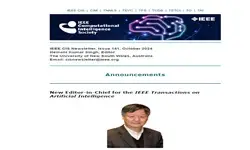Fusion here, there and almost everywhere in computer vision - driving new advances in fuzzy integrals
Derek Anderson
-
Members: FreeCIS
IEEE Members: Free
Non-members: FreeLength: 00:51:54
09 Jul 2017
Derek Anderson, University of Missouri, USA
Abstract: Computer vision is a well-known area where computational intelligence has made a significant impact. In general, the field is diverse and objectives range from filtering to object detection, image understanding and linguistic summarization/description, to name a few. As simple as it may sound, we have been trying to make a computer �describe what it saw� since the 1960s. In an attempt to achieve this goal, researchers have looked to data/information fusion. However, most classical aggregation strategies are additive and assume independence among inputs. On the other hand, fuzzy measure theory provides a powerful parametric way to specify or learn input interactions (when/if available). More importantly, the fuzzy integral utilizes the fuzzy measure to achieve nonlinear aggregation. In this talk, I will discuss the role of nonlinear aggregation via fuzzy integrals at the levels of signal, spectrum, feature, and decision-level fusion. In particular, I highlight recently established extensions of fuzzy integrals designed to address key challenges in computer vision. These extensions focus on spatial and/or distribution level uncertainty and they are embedded into pattern recognition or automated decision making via multiple kernel learning and/or fuzzy logic. Applications are discussed for multi-sensor humanitarian demining, hyperspectral image analysis and remote sensing.
Abstract: Computer vision is a well-known area where computational intelligence has made a significant impact. In general, the field is diverse and objectives range from filtering to object detection, image understanding and linguistic summarization/description, to name a few. As simple as it may sound, we have been trying to make a computer �describe what it saw� since the 1960s. In an attempt to achieve this goal, researchers have looked to data/information fusion. However, most classical aggregation strategies are additive and assume independence among inputs. On the other hand, fuzzy measure theory provides a powerful parametric way to specify or learn input interactions (when/if available). More importantly, the fuzzy integral utilizes the fuzzy measure to achieve nonlinear aggregation. In this talk, I will discuss the role of nonlinear aggregation via fuzzy integrals at the levels of signal, spectrum, feature, and decision-level fusion. In particular, I highlight recently established extensions of fuzzy integrals designed to address key challenges in computer vision. These extensions focus on spatial and/or distribution level uncertainty and they are embedded into pattern recognition or automated decision making via multiple kernel learning and/or fuzzy logic. Applications are discussed for multi-sensor humanitarian demining, hyperspectral image analysis and remote sensing.


